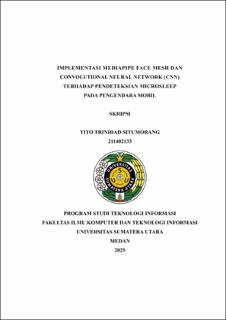Implementasi Mediapipe Face Mesh dan Convolutional Neural Network (CNN) terhadap Pendeteksian Microsleep pada Pengendara Mobil
Implementation of Mediapipe Face Mesh and Convolutional Neural Network (CNN) for Microsleep Detection in Car Drivers

Date
2025Author
Situmorang, Tito Trinidad
Advisor(s)
Pulungan, Annisa Fadhillah
Huzaifah, Ade Sarah
Metadata
Show full item recordAbstract
This study design a real-time microsleep detection system for car drivers. The system is built using MediaPipe Face Mesh and Convolutional Neural Network (CNN) as the main methods. Microsleep, which is a brief loss of consciousness, is very dangerous when someone is driving because it can occur unnoticed and have fatal consequences. To address this issue, MediaPipe Face Mesh is used to identify 468 points on the face to calculate the Eye Aspect Ratio (EAR), which serves as an indicator of drowsiness. The EAR value is combined with the facial image as input into the CNN, which then classifies the driver's condition as “normal” or “microsleep.” The data used is resized to 128x128 pixels for augmentation. Testing on 66 images showed the system's accuracy at 91% with the following model parameters: batch size 32, Conv2D layer, BatchNormalization, MaxPooling2D, Dropout, Flatten, Dense, learning rate, and epoch. The system can also provide an audio warning if microsleep is detected. These results indicate that the combination of MediaPipe Face Mesh and CNN can be a good way to be an effective and efficient solution for detecting microsleep. In addition to operating in real-time on mobile devices, the system remains robust under varying lighting conditions, making it highly promising for enhancing driving safety.
Collections
- Undergraduate Theses [873]
